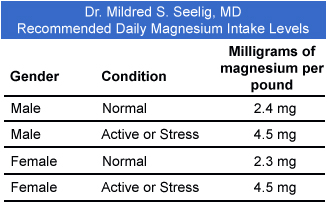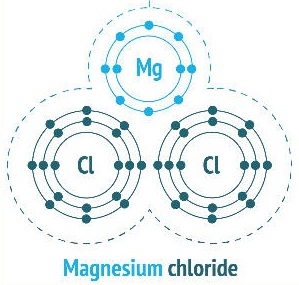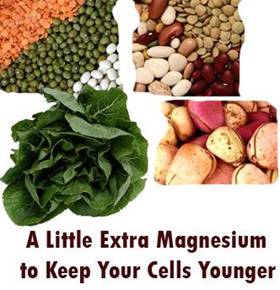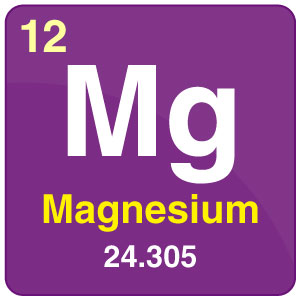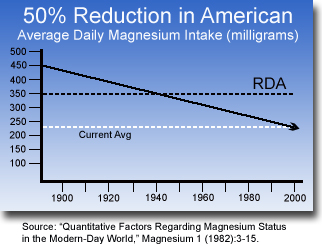Transdermal magnesium chloride oil (MCO) - Most effective, fastest way to increase body's magnesium
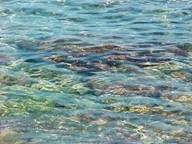

What is MCO?
Magnesium chloride oil (MCO) is magnesium chloride dissolved in water. Although not really an oil, it does feel a little slippery like oil until it is absorbed. Magnesium chloride is the dried liquid remaining after sodium chloride has been removed from sea water. Technically called magnesium chloride hexahydrate, its chemical formula is MgCl2.6H2O. Common names are Nigari and Bittern, which are in the form of flakes or crystals.
How much magnesium in MCO?
One teaspoon of 35% strength MCO contains ~600 mg of elemental magnesium
(1 teaspoon of 33% strength MCO (Ancient Minerals™Mg Oil strength) contains 560 mg of elemental magnesium)

Transdermal magnesium chloride oil used to solve many health problems
Transdermal MCO is the application of a solution of magnesium chloride oil to the skin to provide a remedy for a multitude of health problems resulting from magnesium deficiency in the body – including stress, heart disease, cancer, diabetes, arthritis, fibromyalgia, migraines, aches and pains.
Why are we magnesium deficient?
The Many Health Benefits of Magnesium
Functional health benefits of transdermal MCO include:
- Greater energy
- More relaxed muscles
- Stronger connective tissue. Magnesium oil stimulates body’s production of DHEA – a sex steroid hormone shown to promote collagen production.
- Better sleep
- Improved mental function
- Reduction/elimination of headaches
- Arterial health
- Better hormonal balance for men and women (including better reproductive function, reduced PMS).
- Magnesium maintains the flexibility of cell membranes for greater uptake of bioactive substances (e.g., nutrients, neurotransmitters, and hormones)
- Detoxification of toxins and metabolic waste products.
- Magnesium chloride acts as a full body tonic.

Transdermal MCO is more effective and faster-acting than oral magnesium supplementation
- Bypasses GI tract. The biggest advantage of transdermal magnesium delivery is that the intestines are not adversely impacted by large doses of oral magnesium, which has a potentially laxative effect. Also magnesium absorption issues are avoided by by-passing the stomach and liver. and digestive problems affecting many people.
More bioavailable. The magnesium chloride molecule has its magnesium ion loosely bonded to its 2 chlorine atoms (magnesium chloride has a stability constant of 0), such that its magnesium ion can easily break away for use in cells and tissues;
Some magnesium chloride chemistry
- Transdermal MCO directly raises magnesium levels in specific localized tissues – for the relief of aches, pain, soreness, infection, burns, etc. Localized application is particularly useful for relieving the pain of sore muscles and joints related to magnesium deficiency.
Transdermal MCO is an effective way to quickly raise body’s magnesium stores. Magnesium in a solution of MCO finds its way through the skin and into the blood stream. From there magnesium can be delivered to needy body cells/tissues. Covering a large area of skin or taking a footbath or especially a full immersion bath will swiftly correct a deficiency in the body’s magnesium presence.
When taken transdermally as a daily magnesium supplement, you don’t need as much magnesium as when taken orally – since transdermal magnesium is more bioavailable. A good rule of thumb is to halve the amounts recommended for oral supplementation.

Example uses of transdermal magnesium chloride oil
- Aching/Sore muscles – apply an MCO pack to area and if problem is chronic also use the footbath method.
- Cancer – use the footbath regimen in conjuction with rubbing on skin for 2 months to normalize body’s magnesium levels, which are usually found depleted in cancer patients. Chemotherapy also further depletes magnesium levels
- Fibromyalgia – magnesium deficiency is almost always the root cause of this painful problem.
- Acne, eczema, psoriasis or to rejuvenate/moisturize your facial skin – apply diluted MCO to the face. You may get some initial irritation/inflammatory reaction – experienced as redness, rash or heat as the magnesium goes to work. Don’t go past your comfort level, just dilute the oil some more, even if it takes longer to attain successful results. Also, you can always wash it off with water if you need to. However, once the magnesium has dealt with the problems (after about a week or so of daily application), you may even be able to apply the oil full strength with no more reaction.
- Wounds – MCO is best used as a 4% solution, that is 4 g (a level teaspoon) Magnesium Chloride flakes in 100 ml (about a 4oz glass) of water.
- Bruises
- Personal care uses: Natural deodorant – dab into armpits using fingers or a 100% cotton ball. Dilute as needed, or it may sting (especially if you have recently shaved); Toothpaste; Mouthwash; Hair conditioner

Application methods of transdermal magnesium chloride oil (MCO) to increase magnesium levels
IMPORTANT: Read ALL instructions before applying magnesium chloride oil
Apply MCO to skin and rub in
What strength magnesium chloride oil (MCO) to use?
- 35% strength MCO provides 600 mg elemental magnesium in 1 teaspoon. A small amount to spread over the skin, this concentration is well tolerated by most people without irritation problems on limbs and torso (provided skin is unbroken)
- 35% strength may be too strong for the face and neck and definitely too strong for burns or wounds. For these applications the oil must be appropriately diluted. A 4% solution is recommended for burns and wounds (i.e. dilute1 part 35% oil : 8 parts water).
- Dilute the oil further if you experience too much “stinging”. Use clean, filtered water or spring water. Do not use chlorinated water.
MCO feels slightly slippery like an oil at first (although it’s not really an oil). However, after 1-2 minutes, as absorption occurs, it no longer feels oily.
For relief or treatment of a specific area, E.g. sore muscles, achy joints, muscle spasms, face, neck, scalp, cuts/wounds, burns. Rub thoroughly into that area. The more you rub, the more your skin will absorb; Let dry before covering with clothes.
To increase body’s magnesium levels:
- Apply with hand or spray several body areas. Both arms and legs, and maybe also the abdomen for a large absorption surface area. Again, let it dry before putting clothes over it.
- Or slather whole body. You can even strip down and use a spray bottle or pour oil into your hand to slather and then rub the oil onto your body from the neck down. Next lie down and relax for 30 mins. on an old sheet or towel (or find something to do that is not at odds with being naked), to allow time for oil to soak in. Finish by rinsing off oil in the shower. Don’t use soap. Towel dry.
How much MCO to use? One tsp of MCO (35% solution) contains ~600 mg magnesium, so 1 teaspoon once a day should be ample for most people. Although three to five times daily is recommended for a few weeks for those battling serious illness, to replenish magnesium stores as quickly as possible.
Putting ½ tsp. at a time in the palm of your hand is usually more manageable than trying to apply the whole teaspoon all at once.
Dr. Norman Shealy, MD, Ph.D and neurosurgeon, has found that skin application of Mg chloride oil, with a concentration of at least 25% magnesium chloride, restores intracellular levels within 4-6 weeks.
Avoid sensitive body parts. E.g. the nipples, genital area, eyes, freshly shaved underarms, freshly shaved face. It won’t damage them, but believe me it will sting!
You can leave it on for a few days or at least until your next shower. However, it is best to shower at least every few days because the magnesium residue builds up lessening the skin’s absorption of new applications of oil.
- If the residue that is left itches too much, you can wash it off after 30-40 mins.
If you use lotion or other skin oils, apply them after the magnesium oil. Since by saturating the skin they would hinder the uptake of the magnesium oil, which would be left sitting on top of your skin.
Use damp heat for deeper penetration of oil. E.g. use a magnesium chloride oil pack with a hot water bottle. Moist heat penetrates deep into tissue.
Physical massage much improves absorption into muscles and joints. Spastic muscles have poor blood and lymph circulation, which makes it difficult for the magnesium to dissolve and flush out tissue and joint calcifications. Absorption improves by increasing the circulation through permanently contracted muscles with deep tissue massage, hot and cold water applications, warm packs, and heat-producing rubs with magnesium chloride oil. Moving your lymph via exercise helps flush out the offending calcium accumulations.
Footbath using MCO or magnesium chloride flakes
Using a footbath is a relaxing way to raise body’s magnesium levels. Also, this is the preferred method of application for any health issues with the lower extremities such as the feet, ankles and legs
Instructions:
- Pour 4 ounces of Magnesium Oil or 1-2 Cups magnesum chloride flakes into a heated footbath – if using flakes allow time for them to dissolve. Massaging and/or vibrating option may enhance your experience.
- Add just enough warm (101 -105 °F) water to cover your feet – Do not use water at a temperature of >105 °F, which encourages general excretion rather than absorption.
- Soak clean washed feet for 20-25 minutes
- Dry feet
TO ECONOMISE – DON’T THROW OUT THE WATER – you can reuse it several times – just top it up with some hot water and a little extra oil (well at least until it gets disgusting! -that’s why you wash your feet first).
How often should you take a footbath? if you are trying to remedy a magnesium deficiency, you should take a daily footbath for a week and then 3 times/week for a couple months to increase your body’s magnesium levels.
Add in ¼ cup of baking soda for an extra akalizing therapy. Sodium bicarbonate is used to counter acidity in the body, which is present in most of today’s degenerative health problems. Cancer cannot survive in an alkaline environment, making this additional alkalizing therapy a no-brainer.
Bathtub soak using magnesium chloride flakes
More economical to use magnesium chloride flakes (not oil) for this method
For a severe magnesium deficiency, a bathtub soak in a magnesium chloride is needed to raise body’s magnesium levels quickly. Added benefits are that is very relaxing and baking soda can be added for an extra alkalizing touch.
It is counter-productive if your water is chlorinated. In auch case you will need to use a filter at the supply. Chlorine filters can be found online.
Instructions:
- How many pounds of magnesium chloride flakes to use? Use 2-4 pounds magnesium chloride flakes considering that the more you fill the tub, the more diluted your solution will be (seawater contains ~1300ppm magnesium). Utilizing the principles of balneotherapy, enough magnesium chloride must be added to bath water to make a hypertonic solution (i.e bath has a higher salt concentration than the body). This is an excellent way to both deliver needed trace minerals directly into the body, and to help the body cleanse itself.
Read more:
- The temperature of the magnesium bath should be warm at 101 – 105°F (37 – 40°C ) – rather than hot, for efficient absorption of the magnesium.
- How long? 25-30 minutes is suggested; longer bath times can increase the amount of magnesium absorbed, but you don’t want to be sitting in cold water;
- How often? For four weeks, take no more than 2 bathtub soaks per week. This is a powerful way to improve your magnesium levels, but be aware that you can have too much of a good thing. Too much magnesium becomes unbalanced with the body’s calcium and can result in muscle weakness—take note of sensations while in the tub, or muscle weakness outside the tub. If this occurs take some good calcium to counteract the magnesium overdose.
Magnesium chloride oil (MCO) pack
Instructions:
- Make a compress pack. Fold a piece of 100% wool, soft cotton or small towel into 3 or 4 layers and soak in magnesium chloride oil to make a pack.
- Heat in a low-heated pan or the microwave. Make sure it is not too hot.
- Place pack over area of concern. E.g. tumors, infected, inflamed, painful/stiff/calcified joints or muscles, adhesions or scar tissue.
- Cover with plastic and a dry towel for insulation and leave for 1-2 hours. For best absorption, place a hot water bottle over the pack to keep it warm.
- Pack can be reused a few times. Keep it wrapped in plastic, and refresh with a little more oil at the next use.

MgCl2: Possible Counter Indications and Warnings
- TOO MUCH magnesium can cause muscle weakness, decreased reflexes and disordered cardiac rhythm. If this happens temporarily use more calcium. Having said this, it is unlikely that the use of transdermal magnesium could cause a problem with an overdose, any more than would regularly swimming in the ocean.
- If someone has kidney failure or is on a dialysis machine, excess magnesium will build up because it will not be eliminated in the urine. Magnesium supplementation should NOT be attempted without medical supervision
- TOO MUCH magnesium can cause muscle weakness, decreased reflexes and disordered cardiac rhythm. Â If this happens temporarily use more calcium. Having said this, it is unlikely that the use of transdermal magnesium could cause a problem with an overdose, any more than would regularly swimming in the ocean.
- Those with an excessively slow heart rate
- Those with myasthenia gravis (rare chronic autoimmune disease causing muscle weakness)
- Those with severe adrenal weakness or low blood pressure need to be careful. Those with low blood pressure usually require extra calcium in addition to magnesium. Normal blood pressure is about 120/80; the lower it is, the higher the need for daily calcium supplementation. While those with high blood pressure benefit from ingesting twice as much magnesium as calcium, those with low blood pressure may take twice as much calcium as magnesium, but both in relatively high amounts. Those with low blood pressure and inflammatory tendencies should also significantly reduce their phosphorus intake, since a high levels of phosphorus in the body tends to deplete magnesium and calcium
How to make magnesium chloride oil

How to Make a 35% Magnesium Chloride Solution
A 35.36% MgCl2 Oil (MgCl2 solution) contains 600mg /elemental magnesium in 1 teaspoon – this is the desireable daily dose for most adults:
Makes ~ 65 teaspoons – lasts about 2 months using 1 tsp / day
- Pour 1 ¼ Cups (~8oz) Magnesium Chloride (nigari) flakes into a one-quart bottle or jar
- Add ¾ Cup + 1 Good Tablespoon (~6.6 oz) purified water – The flakes will absorb the water gradually over the course of 1- 2 hours. You can swirl it around to speed up the process. Once it has reached a murky stage, you can begin using it.
Mixture will feel oily – even though there is no oil in either the water or the magnesium chloride flakes.
The Math: How ADDING 6.6 oz water to 8oz flakes yields ~35% MgCl2 Solution
- 8 oz.MgCl2 * 47% (= 3.76) oz MgCl2 contains 8oz * 50.5% (= 4.04) oz water
- Adding 6.6 oz water = Total of 10.64 oz water, which gives (3.76 oz.MgCl2 / 10.64 oz. water) * 100%= 35.36 % solution
How to Make a 33% Magnesium Chloride Solution
33% solution contains 33% magnesium chloride in water
How to Make 33% MgCl2 solution using 8 oz MgCl2 flakes.
8oz (~1 ¼ Cup) MgCl2 flakes contains:
- MgCl2 – 8oz * 47% = 3.76 oz MgCl2
- Water – 8oz * 50.5% = 4.04 oz water
8oz flakes (i.e. 3.76 oz MgCl2) needs to be dissolved in 11.39 oz water for 33% solution (100 /33 *3.76 = 11.39
Since flakes already contain 4.04 ounces of water, we must add ~7.35 oz. (approx. ¾ Cup + 2 Teaspoons) water (i.e. 11.39 oz less 4.04 oz)

Some magnesium chloride chemistry
- Magnesium chloride formula is MgCl2
- Atomic weight of MgCl2 is 95.211g. Calculated as 24.305 g (At.wt. of Mg) + 2 atoms x 35.453 g (Atomic Weight of Chlorine)
- Elemental magnesium is 25.527% of MgCl2 calculated as. 24.305 / 95.211 x 100% of MgCl2
How much elemental magnesium in a certain percentage MgCl2 solution?
There are 560 mg elemental Mg in 1 teaspoon of a 33% MgCl2 solution (This is the strength of Ancient Minerals Magnesium OIl™)
So there are “560 x ?/33 “mg of Magnesium in 1 teaspoon of ?% solution
E.g. In a 35.36% solution, there are 560*35.36/33 = 600 mg Elemental Magnesium
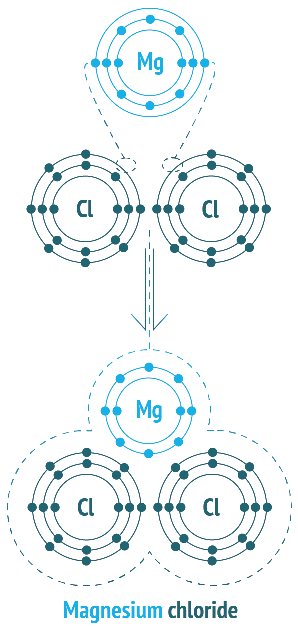
Magnesium Chloride flakes (nigari) are:
- 47% MgCl2
- ~ 50.5% water.
1 cup Magnesium chloride flakes contains approx. 51g magnesium chloride
Magnesium chloride molecule
Magnesium chloride has a stability constant of zero, meaning it is fully ionized and easily separated / dissociated into magnesium ions and chloride.
There is an ionic bond (attraction of opposite charges) between the magnesium ion and each of the chlorine ions as the magnesium gives each chlorine ion an electron to fill their outer shells with the maximum 8 electrons.













